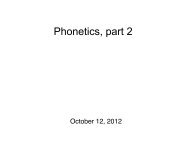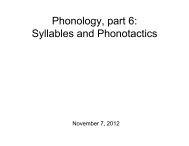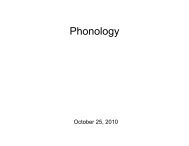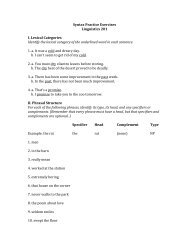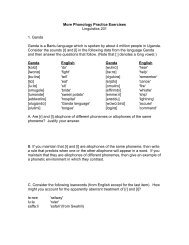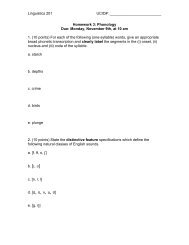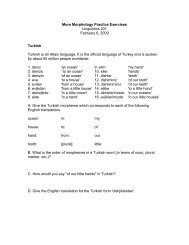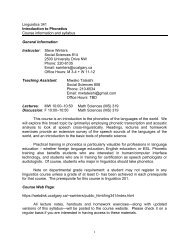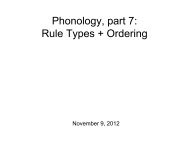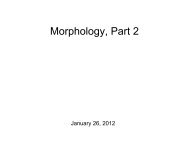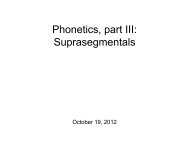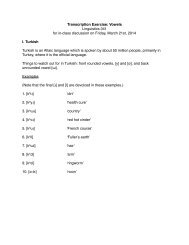Approximants + Secondary Articulations - Bases Produced
Approximants + Secondary Articulations - Bases Produced
Approximants + Secondary Articulations - Bases Produced
You also want an ePaper? Increase the reach of your titles
YUMPU automatically turns print PDFs into web optimized ePapers that Google loves.
<strong>Approximants</strong> +<br />
<strong>Secondary</strong> <strong>Articulations</strong><br />
November 27, 2009
Minor Details<br />
• Transcription exercise for Monday:<br />
• Bengali (VOT distinctions)<br />
• Arabic (Fricatives)<br />
• Quebec French (Fricatives + <strong>Approximants</strong>)<br />
• For next Friday: final production exercise (#4)<br />
• Both assignments have already been posted….<br />
• Your production exercise #3 grades will be returned by<br />
Monday.
Review Time<br />
• So far, we have talked in detail about the following classes<br />
of sounds:<br />
• Vowels<br />
• Stops<br />
• Trills<br />
• Fricatives<br />
• Affricates<br />
• Ejectives, Implosives, Clicks<br />
• A basic distinction: vowels and consonants
• Vowels<br />
Vowels and Consonants<br />
• Relatively unconstricted flow of air through vocal tract<br />
(above the glottis)<br />
• Shape (filter) the source of sound made at the glottis<br />
• Consonants<br />
• Completely or severely constricted flow of air through<br />
vocal tract (above the glottis)<br />
• Create a source of sound at the constriction (e.g.,<br />
release bursts, turbulence)<br />
• Voicing may be difficult<br />
• Note: this is a phonological distinction, not a phonetic one.
Obstruents and Sonorants<br />
• Phonologically speaking, there are also different kinds of<br />
consonants.<br />
• One important distinction is between obstruents and<br />
sonorants.<br />
• Obstruents<br />
• Stops, fricatives, affricates<br />
• Obstruct flow of air through the vocal tract so much that<br />
voicing is difficult<br />
• Sonorants<br />
• Nasals, approximants (glides, liquids), trills, flaps<br />
• Allow air to flow freely through vocal tract so that<br />
resonance (voicing) is still possible
<strong>Approximants</strong><br />
• <strong>Approximants</strong> = one articulator is close to another, but<br />
without producing audible turbulence.<br />
• They come in two flavors:<br />
1. Glides (English [w], [j])<br />
2. Liquids (English , [l])<br />
• This distinction is also phonological…<br />
• Glides are essentially high-vowel articulations which<br />
are not in a syllabic peak.<br />
• In English, liquids may form syllables (or syllable<br />
peaks).
Glides<br />
• Each glide corresponds to a different high vowel.<br />
Vowel Glide Place<br />
[i] [j] palatal (front, unrounded)<br />
[u] [w] labio-velar (back, rounded)<br />
[y] labial-palatal (front, rounded)<br />
velar (back, unrounded)
Glide Examples<br />
• French contrasts palatal, labio-palatal and labio-velar<br />
glides:<br />
• Japanese has velar vowels, but not necessarily velar<br />
glides...
Glide Acoustics<br />
• Glides are shorter than vowels<br />
• They also tend to lack “steady states”<br />
• and exhibit rapid transitions into (or from) vowels<br />
• hence: “glides”<br />
• Also: lower in intensity<br />
• especially in the higher formants
[j] vs. [i]
[w] vs. [u]
Vowel-Glide-Vowel<br />
[iji] [uwu]
More Glides<br />
[wi:] [ju:]
<strong>Secondary</strong> <strong>Articulations</strong><br />
• A secondary articulation is made by superimposing a<br />
glide-like articulation on top of another constriction<br />
elsewhere in the vocal tract.<br />
• Note that secondary articulations are different from<br />
double articulations.<br />
• In double articulations, both constrictions are of equal<br />
degree.<br />
• Ex: labio-velar stops ([kp])<br />
• With secondary articulations, there are two constrictions<br />
with an unequal degree of closure.<br />
• primary articulation: more constricted<br />
• secondary articulation: less constricted
Primary / <strong>Secondary</strong><br />
• One example of a secondary articulation is velarized .<br />
• Also symbolized:<br />
• Primary articulation: [l]<br />
• direct contact with tongue tip<br />
• <strong>Secondary</strong> articulation:<br />
• approximation of velum with back of tongue<br />
• The other commonly found secondary articulations are:<br />
• [ w ] labialization<br />
• [ j ] palatalization<br />
• pharyngealization
Labialization Examples<br />
• In labialization, lip rounding (specifically, protrusion) is<br />
superimposed on a fricative or stop constriction.<br />
• Examples from Bura (spoken in Nigeria):
Timing<br />
• The reason that [k w ] is not transcribed as [kw] has to do<br />
with timing.<br />
• [k w ]: peak of labial protrusion occurs during stop closure<br />
velum<br />
lips<br />
[k]<br />
[ w ]<br />
• [kw]: peak of labial protrusion occurs after stop closure<br />
velum<br />
lips<br />
[k]<br />
[w]
[m] vs. [m w ]<br />
[m w anta]
Palatalization<br />
• Consonants are palatalized by making a secondary [j]<br />
constriction.<br />
• Russian has contrastive palatalized consonants.
[p] vs. [p j ] vs. [pj]<br />
“sweat” (male name) “drink”
Post-vocalic Position<br />
[tot h ]<br />
• The acoustic effects of secondary articulations<br />
operate in reverse, when they appear after a vowel.
Pharyngealization<br />
• Consonants are pharyngealized by superimposing a<br />
pharynx narrowing gesture on the regular consonant<br />
articulation.<br />
• Mid-sagittal diagrams from Arabic:
Arabic Examples<br />
• Arabic contrasts pharyngealized and non-pharyngealized<br />
consonants.
[ti:n]<br />
[t] vs.<br />
• Pharyngeal constrictions raise F1 and lower F2<br />
• an -like formant pattern
• What about F3 distinctions?<br />
• They’re unusual.<br />
• For auditory reasons:<br />
A Note About F3<br />
• sensitivity to frequency distinctions drops off in the<br />
higher frequency regions.<br />
• However: English has very low F3.
English<br />
• English is distinctive because it has a very low F3.
And Again
Toothpick Time<br />
• typically combines three different approximant<br />
constrictions:<br />
1. Post-alveolar (retroflex)<br />
2. Lip rounding (labialization)<br />
3. Pharyngeal constriction (pharyngealization)<br />
• Hence, might be a better transcription.<br />
• English speakers make the retroflex constriction in two<br />
different ways:<br />
1.Tongue bunching<br />
2.Tongue curling<br />
• ⇒ The articulation of is very complex.
Bunching and Curling
Back to the videotape…
Rhoticized Vowels<br />
• Retroflexion is a feature which may be superimposed on<br />
other vowel articulations.<br />
• These vowels are said to be rhoticized.<br />
• Rhoticized vowels are contrastive in Badaga, a language<br />
spoken in southern India.
Retroflex Vowel Spectrograms<br />
[be]
Rhoticized vowels in English<br />
• Vowels before in Canadian + American English are<br />
consistently rhoticized.<br />
• Check out Bruce + Peter’s productions of “hard”.<br />
• Recall that there is a reduced set of vowel contrasts in<br />
this environment:<br />
•<br />
• Also note that there are alternative transcriptions for<br />
syllabic .<br />
• Namely:



